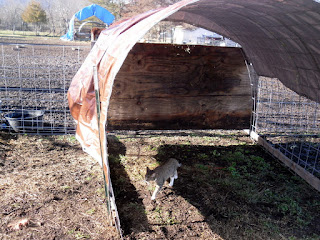 |
| You need 4 t-posts; 2 8-ft. 2X4's; 2 16-ft heavy duty cattle panels; 1 9X12 heavy duty tarp 1 4X8 sheet of plywood |
We've been raising sheep and goats since 1982. We keep our flocks small, breed for the very best and attempt to improve our land and remain sustainable.
It rains a decent amount here. Our yearly average is in the 50-inch range. In fact, all our weather is mostly middlin'. Four good solid seasons with a good range of all weather possibilities. However, we do have infrequent wind. I'm not sure how the hoop houses would hold up in an area with constant wind.
 |
| Pound the t-posts in a rectangle so that the 2X4's fit inside the posts and the plywood sets on top of the boards at the back. |
To go along with this, we build shelters that we call hoop houses. They are simple to put up, taking only about 1/2 hour with two of us if we have all the materials ready. They are comfortable shelter for four of our small breed sheep or goats. If we have more than 4 animals in a pen, we build 2 or more hoop houses, side-by-side. Then we can use the V between the two shelters for a hay feeder.
 |
| Bend the two cattle panels and lift them to fit between the two boards. |
2 Cattle Panels @ $25 ea. = $50.00
4 t-posts @ $4.00 ea. = $16.00
2 2X4's @ $4.00 ea. = $8.00
1 Sheet plywood @$12.00=$12.00
1 tarp @ $15.00 = $15.00
 |
| Stretch the tarp over the panels. We need air circulation here, so we leave the gaps at the bottom. Kitty is our construction foreman. |
This process works well for our flock management.
 |
| Tie the cattle panels together with baling twine. |


2 comments:
im going to try this !
Going to try building this for our sheep.
Post a Comment